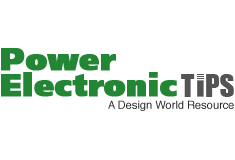We recently spent an afternoon perusing the web in search of good power electronics stuff. We came up with a dozen sites that provided educational material or other information that can come in handy for engineers working in power electronics.
Switching-Mode Power Supply Websites –- The creator of this list of sites says the major criteria for inclusion is that the listed site must provide some practical non-product advice to the working power supply designer or student. The creator also included sites maintained by power electronics authors on his must-read list.
http://www.smpstech.com/websites.htm
Basic Electronics Tutorials for beginners and beyond – Bunch of pages here on discrete power electronic semiconductors that include thyristors, triacs, diacs, IGBTs, unijunction transistors, and other components. Also gets into some basic electronic concepts such as sinusoidal waveforms, rms voltage, phasors and vectors, series/parallel circuits, and a lot more.
http://www.electronics-tutorials.ws/
MIT’s OpenCourseWare – The well-known MIT OpenCourseWare online program includes an offering in power electronics and, of course, it is completely free. The power electronics course examines the application of electronics to energy conversion and control. Topics covered include: modeling, analysis, and control techniques; design of power circuits including inverters, rectifiers, and DC-DC converters; analysis and design of magnetic components and filters; and characteristics of power semiconductor devices. Application examples cover motion control systems, power supplies, and radio-frequency power amplifiers. The course is worth 6 engineering design points.
The Center for Power Electronics Systems (CPES) – Maintained by Virginia Tech, CPES works on projects to improve electrical power processing and distribution that impact systems of all sizes – from battery-operated electronics to vehicles to regional and national electrical distribution systems. It does power electronics research in five technology areas: (1) power conversion technologies and architectures; (2) power electronics components; (3) modeling and control; (4) EMI and power quality; (5) high density integration. The Center targets applications in (1) Power management for information and communications technology; (2) Point-of-load conversion for power supplies; (3) Vehicular power conversion systems; (4) Renewable energy systems. You can get a good technical description of specific research efforts at the Center’s website.
National Instruments Power Electronics Fundamentals – Nationalp Instruments, the company that created the LabView program, has a short course on power electronics designed to provide an overview of concepts used in research and taught throughout worldwide institutions. The course material makes use of National Instruments software called Multisim which is a simulation program for characterizing power circuits. There are free versions of Multisim available, so it’s possible to go through the course without spending a dime.
http://www.ni.com/white-paper/14677/en/
Coursera – Coursera is another free education platform that partners with universities and organizations worldwide to offer courses online. The power electronics course is an introduction to switched-mode power converters. It provides a basic knowledge of circuitry for the control and conversion of electrical power with high efficiency. These converters can change and regulate the voltage, current, or power; dc-dc converters, ac-dc rectifiers, dc-ac inverters, and ac-ac cycloconverters are in common use. Applications include electronic power supplies, aerospace and vehicular power systems, and renewable energy systems. The course comes from the University of Colorado.
https://www.coursera.org/course/powerelectronics
Next Generation Power Electronics National Manufacturing Innovation Institute – If you are interested in wide-bandgap power semiconductors such as GaN, you might want to keep an eye on this site. The Institute is one of three innovation hubs announced by President Obama in his 2013 State of the Union address and part of the National Network for Manufacturing Innovation (NNMI). The Institute aims to create, showcase, and deploy new power electronic capabilities, products, and processes that can impact commercial production, build workforce skills, enhance manufacturing capabilities, and foster long-term economic growth. You can get a heads-up on what’s going on in current research topics here.
Lazar’s Power Electonics Guide – There is a lot of tutorial stuff on switch-mode power supply basics on the pages of this site. Included here are circuit explanations, schematics, a general electrical engineering reference, software, and other info.
Educypedia – Educypedia is an information resource about electronics, science, engineering, and information technology. All the links are tested with respect to content, and there’s nothing here that is commercial.
http://educypedia.karadimov.info/electronics/electronicaopening.htm
Free online Basic Electronics Course – This tutorial material is organized so you can just read the brief blocks of text, view the videos, and check out some of the screened internet links. There are also a few links to books that can help expand and speed the learning process.
http://101science.com/Radio.htm
Who’s Who in Power Electronics – The field of power electronics has, until recently, been relatively small. Practitioners tend to hear the same names come up repeatedly. This site contains short biographies of some big-names in this field so you can find out who people like Slobodan Cuk or Dave Middlebrook are.
http://www.kmitl.ac.th/emc/vuttipon/who’s%20who%20in%20PE.htm
Introduction to Snubber Design – Virtually every power electronics circuit requires a snubber. This website’s goal is to provide good papers, application notes, or books that helps circuit design engineers solve your snubber design problem.


Leave a Reply